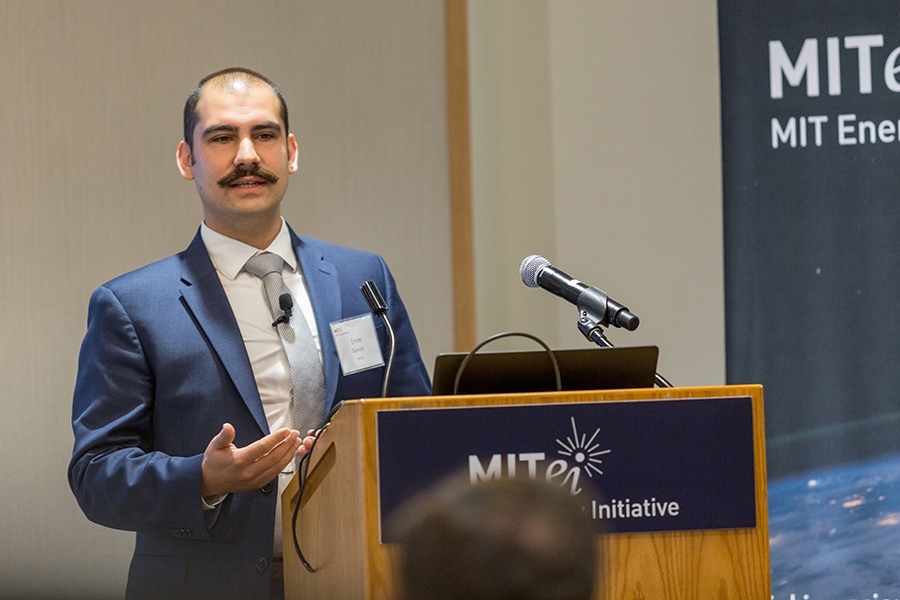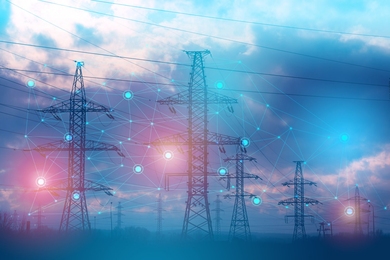As the world increasingly recognizes the need to develop more sustainable and renewable energy sources, low-carbon hydrogen has reemerged as an energy carrier with the potential to play a key role in sectors from transportation to power.
At MITEI’s 2019 Spring Symposium, MIT Energy Initiative Research Scientist Emre Gençer gave a presentation titled “Hydrogen towards Deep Decarbonization,” in which he elaborated on how hydrogen can be used across all energy sectors. Other themes discussed by experts at the symposium included industry’s role in promoting hydrogen, public safety concerns surrounding the hydrogen infrastructure, and the policy landscape required to scale hydrogen around the world.
Here, Gençer shares his thoughts on the history of hydrogen and how it could be incorporated into our energy system as a tool for deep decarbonization to address climate change.
Q: How has public perception of hydrogen changed over time?
A: Hydrogen has been in the public imagination since the 1870s. Jules Verne wrote that “water will be the coal of the future” in his novel “The Mysterious Island.” The concept of hydrogen has persisted in the public imagination for over a century, though interest in hydrogen has changed over time.
Initial conversations about hydrogen focused on using it to supplement depleting fuel sources on Earth, but the role of hydrogen is evolving. Now we know that there is enough fuel on Earth, especially with the support of renewable energy sources, and that we can consider hydrogen as a tool for decarbonization.
The first “hydrogen economy” concept was introduced in the 1970s. The term “hydrogen economy” refers to using hydrogen as an energy carrier, mostly for the transportation sector. In this context, hydrogen can be compared to electricity. Electricity requires a primary energy source and transmission lines to transmit electrons. In the case of hydrogen, energy sources and transmission infrastructure are required to transport protons.
In 2004, there was a big initiative in the U.S. to involve hydrogen in all energy sectors to ensure access to reliable and safe energy sources. That year, the National Research Council and National Academy of Engineering released a report titled “The Hydrogen Economy: Opportunities, Costs, Barriers, and R&D Needs.” This report described how hydrogen could be used to increase energy security and reduce environmental impacts. Because its combustion yields only water vapor, hydrogen does not produce carbon dioxide (CO2) emissions. As a result, we can really benefit from eliminating CO2 emissions in many of its end-use applications.
Today, hydrogen is primarily used in industry to remove contaminants from diesel fuel and to produce ammonia. Hydrogen is also used in consumer vehicles with hydrogen fuel cells, and countries such as Japan are exploring its use in public transportation. In the future, there is ample room for hydrogen in the energy space. Some of the work I completed for my PhD in 2015 involved researching efficient hydrogen production via solar thermal and other renewable sources. This application of renewable energy is now coming back to the fore as we think about “deep decarbonization.”
Q: How can hydrogen be incorporated into our energy system?
A: When we consider deep decarbonization, or economy-wide decarbonization, there are some sectors that are hard to decarbonize with electricity alone. They include heavy industries that require high temperatures, heavy-duty transportation, and long-term energy storage. We are now thinking about the role hydrogen can play in decarbonizing these sectors.
Hydrogen has a number of properties that make it safer to handle and use than the conventional fuels used in our energy system today. Hydrogen is nontoxic and much lighter than air. In the case of a leak, its lightness allows for relatively rapid dispersal. All fuels have some degree of danger associated with them, but we can design fuel systems with engineering controls and establish standards to ensure their safe handling and use. As the number of successful hydrogen projects grows, the public will become increasingly confident that hydrogen can be as safe as the fuels we use today.
To expand hydrogen’s uses, we first need to explore ways of integrating it into as many energy sectors as possible. This presents a challenge because the entry points can vary for different regions. For example, in colder regions like the northeastern U.S., hydrogen can help provide heating. In California, it can be used for energy storage and light-duty transportation. And in the southern U.S., hydrogen can be used in industry as a feedstock or energy source.
Once the most strategic entry points for hydrogen are identified for each region, the supporting infrastructure can be built and used for additional purposes. For example, if the northeastern U.S. implements hydrogen as its primary source of residential heating, other uses for hydrogen will follow, such as for transportation or energy storage. At that point, we hope that the market will shift so that it is profitable to use hydrogen across all energy sectors.
Q: What challenges need to be overcome so that hydrogen can be used to support decarbonization, and what are some solutions to these challenges?
A: The first challenge involves addressing the large capital investment that needs to be made, especially in infrastructure. Once industry and policymakers are convinced that hydrogen will be a critical component for decarbonization, investing in that infrastructure is the next step. Currently, we have many hydrogen plants — we know how to produce hydrogen. But in order to move toward a semi-hydrogen economy, we need to identify the sectors or end users that really require or could benefit from using hydrogen. The way I see it, we need two energy vectors for decarbonization. One is electricity; we are sure about that. But it's not enough. The second vector can be, and should be, hydrogen.
Another key issue is the nature of hydrogen production itself. Though hydrogen does not generate any emissions directly when used, hydrogen production can have a huge environmental impact. Today, close to 95 percent of its production is from fossil resources. As a result, the CO2 emissions from hydrogen production are quite high.
There are two ways to move toward cleaner hydrogen production. One is applying carbon capture and storage to the fossil fuel-based hydrogen production processes. In this case, usually a CO2 emissions reduction of around 90 percent is feasible.
The second way to produce cleaner hydrogen is by using electricity to produce hydrogen via electrolysis. Here, the source of electricity is very important. Our source of hydrogen needs to produce very low levels of CO2 emissions, if not zero. Otherwise, there will not be any environmental benefit. If we start with clean, low-carbon electricity sources such as renewables, our CO2 emissions will be quite low.









